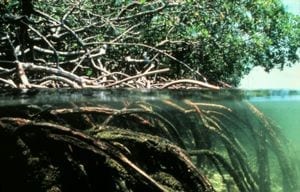Coastal ecosystems store carbon, conserve biodiversity and help protect local economies such as fishing for a nominal cost
Found along the edges of much of the world’s tropical coastlines, mangroves are absorbing carbon dioxide from the atmosphere at an impressive rate. Protecting them, a recent study says, could yield climate benefits, biodiversity conservation and protection for local economies for a nominal cost — between $4 and $10 per ton of CO2.
Mangrove forests are ecosystems that lie at the confluence of freshwater rivers and salty seas. While they make up only 0.7 percent of the world’s forests, they have the potential to store about 2.5 times as much CO2 as humans produce globally each year.
These environments, along with other forms of coastal ecosystems such as tidal marshes and sea grasses, have been given the name “blue carbon” to differentiate them from the “green” carbon of other forests, where carbon is absorbed above ground in trees.
Juha Siikamäki, a fellow at the environmental economic think tank Resources for the Future and lead author of the study, says efforts to maintain mangroves could add an enormous potential for carbon offset projects. First, their importance must be publicized.
“We’re considerably behind what’s been accounted with forest carbon,” he said, referencing the reforesting projects in tropical forests that have garnered investment in the past two decades.
Shrimp aquaculture, fishing and rice growing — especially in Southeast Asia — are slowly degrading mangroves. Every five to 20 years, a biological or chemical problem affects a pond, forcing farmers or fishermen to abandon the area and dig a new pond in an undisturbed mangrove forest. A World Bank study last year found that the removal of the typical coastal wetland has added about 2,000 metric tons of carbon dioxide per square kilometer per year to the atmosphere over 50 years (ClimateWire, April 12, 2011).
NGOs, World Bank look to ‘blue’ portfolios
Although Siikamäki’s study ties successful conservation to the price of offsets in mandatory and voluntary carbon markets, the researchers also took into account other benefits unrelated to carbon, like maintaining species diversity. By switching from a strictly carbon-centric approach to a biodiversity approach, conservation efforts would cost only $1 more.
via Scientific American – Tiffany Stecker and ClimateWire
The Latest Streaming News: Restoring Mangroves updated minute-by-minute
Bookmark this page and come back often
Latest NEWS
Latest VIDEO








